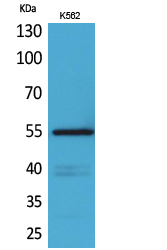CD55 Polyclonal Antibody
- Catalog No.:YT5250
- Applications:WB;ELISA
- Reactivity:Human;Mouse
- Target:
- CD55
- Fields:
- >>Complement and coagulation cascades;>>Hematopoietic cell lineage;>>Viral myocarditis
- Gene Name:
- CD55
- Protein Name:
- Complement decay-accelerating factor
- Human Gene Id:
- 1604
- Human Swiss Prot No:
- P08174
- Immunogen:
- The antiserum was produced against synthesized peptide derived from the Internal region of human CD55. AA range:241-290
- Specificity:
- CD55 Polyclonal Antibody detects endogenous levels of CD55 protein.
- Formulation:
- Liquid in PBS containing 50% glycerol, 0.5% BSA and 0.02% sodium azide.
- Source:
- Polyclonal, Rabbit,IgG
- Dilution:
- WB 1:500 - 1:2000. ELISA: 1:20000. Not yet tested in other applications.
- Purification:
- The antibody was affinity-purified from rabbit antiserum by affinity-chromatography using epitope-specific immunogen.
- Concentration:
- 1 mg/ml
- Storage Stability:
- -15°C to -25°C/1 year(Do not lower than -25°C)
- Other Name:
- CD55;CR;DAF;Complement decay-accelerating factor;CD55
- Observed Band(KD):
- 42kD
- Background:
- This gene encodes a glycoprotein involved in the regulation of the complement cascade. Binding of the encoded protein to complement proteins accelerates their decay, thereby disrupting the cascade and preventing damage to host cells. Antigens present on this protein constitute the Cromer blood group system (CROM). Alternative splicing results in multiple transcript variants. The predominant transcript variant encodes a membrane-bound protein, but alternatively spliced transcripts may produce soluble proteins. [provided by RefSeq, Jul 2014],
- Function:
- domain:The first Sushi domain (SCR1) is not necessary for function. SCR2 and SCR4 provide the proper conformation for the active site on SCR3.,function:This protein recognizes C4b and C3b fragments that condense with cell-surface hydroxyl or amino groups when nascent C4b and C3b are locally generated during C4 and c3 activation. Interaction of daf with cell-associated C4b and C3b polypeptides interferes with their ability to catalyze the conversion of C2 and factor B to enzymatically active C2a and Bb and thereby prevents the formation of C4b2a and C3bBb, the amplification convertases of the complement cascade.,online information:Blood group antigen gene mutation database,online information:CD55 mutation db,online information:Decay-accelerating factor entry,online information:Icosahedral capsid structure,polymorphism:Responsible for the Cromer blood group system. It consists of at least
- Subcellular Location:
- [Isoform 1]: Cell membrane; Single-pass type I membrane protein.; [Isoform 2]: Cell membrane; Lipid-anchor, GPI-anchor.; [Isoform 3]: Secreted .; [Isoform 4]: Secreted .; [Isoform 5]: Secreted .; [Isoform 6]: Cell membrane ; Lipid-anchor, GPI-anchor .; [Isoform 7]: Cell membrane ; Lipid-anchor, GPI-anchor .
- Expression:
- Expressed on the plasma membranes of all cell types that are in intimate contact with plasma complement proteins. It is also found on the surfaces of epithelial cells lining extracellular compartments, and variants of the molecule are present in body fluids and in extracellular matrix.
- June 19-2018
- WESTERN IMMUNOBLOTTING PROTOCOL
- June 19-2018
- IMMUNOHISTOCHEMISTRY-PARAFFIN PROTOCOL
- June 19-2018
- IMMUNOFLUORESCENCE PROTOCOL
- September 08-2020
- FLOW-CYTOMEYRT-PROTOCOL
- May 20-2022
- Cell-Based ELISA│解您多样本WB检测之困扰
- July 13-2018
- CELL-BASED-ELISA-PROTOCOL-FOR-ACETYL-PROTEIN
- July 13-2018
- CELL-BASED-ELISA-PROTOCOL-FOR-PHOSPHO-PROTEIN
- July 13-2018
- Antibody-FAQs
- Products Images

- Western Blot analysis of K562 cells using CD55 Polyclonal Antibody. Secondary antibody(catalog#:RS0002) was diluted at 1:20000

- Western blot analysis of lysate from K562 cells, using CD55 Antibody.



